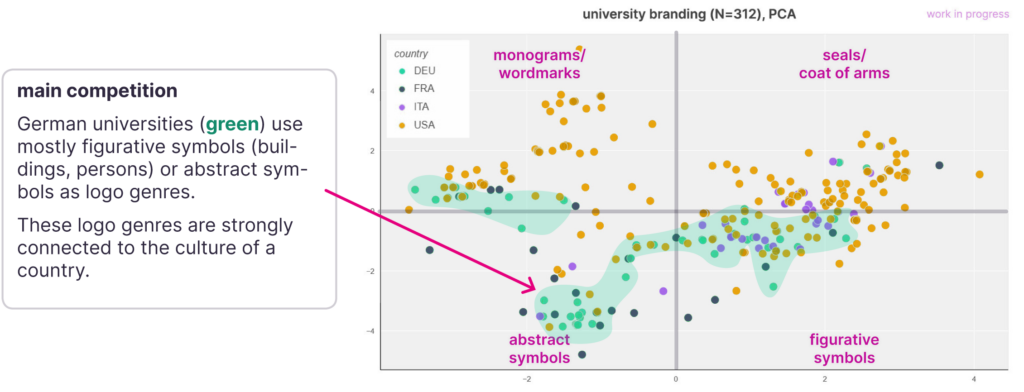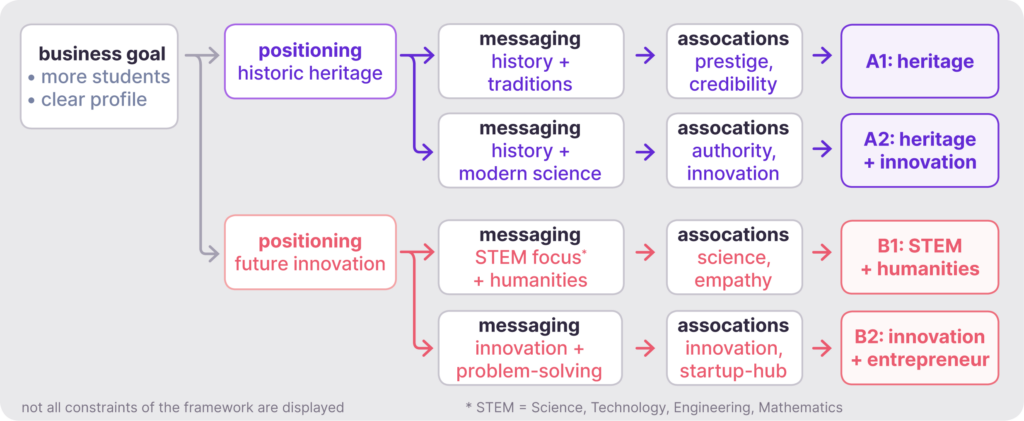In this case study, we show a novel way to speed up a branding process. The “Universität Salzthal” is a fictional university branding project. We begin with a data-driven visual competitor analysis, then link each design option to a clear positioning, similar to OKRs.
To clarify strategic choices, we use “design paths.” They tie each creative direction to a positioning. By focusing on data and strategy, we cut guesswork and speed up the branding process.

Summary, TL;DR
- case study for a fictional university branding
- approach: visual data analysis and OKR-inspired “design paths”
- key win: faster brand alignment and better insight into competition
- benefit: reduced guesswork and clearer stakeholder buy-in
Challenge: complex projects with no clear path
Branding projects often become too complex. This leads to long, aimless brainstorming sessions that lack focus. One key mistake is using random mood boards and scattered ideas. They rarely track back to core business goals or the target audience. Non-design stakeholders also find it hard to decide on a visual style. In turn, the brand can drift away from its objectives, putting the entire project at risk.
These pitfalls cause major risks:
- Analysis paralysis: Too many ideas, no clear focus
- Poor transparency: Stakeholders can’t see how strategy shapes design
- Wasted time: Endless brainstorming with no tangible progress
Solution: Visual Competitive Audit and “Design Paths”
For universities the style of their seal or logo mostly determines they key visual direction. Therefore, we mapped the competitive space.
- Visual Competitive Landscape
We analyzed 300+ university logos by style (emblems, wordmarks, etc.) to spot trends and gaps. This gives stakeholder a “visibility map” to see where are promising spaces to stand out. This already gives possible ideas for visual directions.

It makes it also easy to see the distribution of visual strategies of the leading German universities.

- Strategic “Design Paths”
“Design Paths” are specific directions, that align the business objectives (e.g. attract more STEM interest) with the positioning and the visual direction. Each path outlines a selection of typography, colors, shapes and visual language to evoke associations that match this direction.

- Faster Iterations and clear adjustments
We created 2–3 quick prototypes for each path, all tied to a core positioning. If a concept does not fit, we refined it or switch paths—keeping details intact and the goal in view.

Regular checkpoints of messaging, visuals, and brand direction de-risk the process by validating assumptions before the next steps. This keeps potential pitfalls low and the project on track.
Results: Fast Prototypes aligned with business strategy
By linking each visual decision to a positioning, like focus on historic heritage vs. future innovation we produced two distinct “design paths,” each with two variations.
PATH 1: heritage & innovation
- Variation A1: reflect tradition and heritage of the university founded in 1650

- Variation A2: blending the historic foundation with an up-to date appeal

PATH 2: Focus on Science and Innovation
- Variation B1: Frame the heritage of the university within the combination of Humanities + Modern Applied Sciences

- Variation B2: Focus strongly on an innovation and entrepreneurship character, but keep a connection to the historic foundations with an reinterpretation of symbols of knowledge

Conclusion: fast-tracked branding aligned with business goals
Design doesn’t have to be guesswork. By using data-based design paths, you can test multiple creative ideas—each tied to real business goals. This reduces risks, speeds approval, and aligns your brand with your audience.
With key decisions rooted in evidence and defined objectives, you move past opinions. It’s about results you can base on foundations. That’s the power of an data-led approach.
Ready for clear branding? Let’s talk. Our “Design Paths” framework gives startups and SMEs a direct route to a distinct, goal-oriented identity.
references
- images created with Dall-E 3 / Leonardo.Ai
- Brooke Cagle (unsplash), Tshirt Mockup
- Leonhard Niederwimmer (unsplash), Salzburg
- googledeepmind (pexels), ai visualization